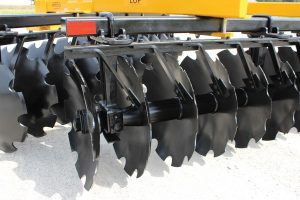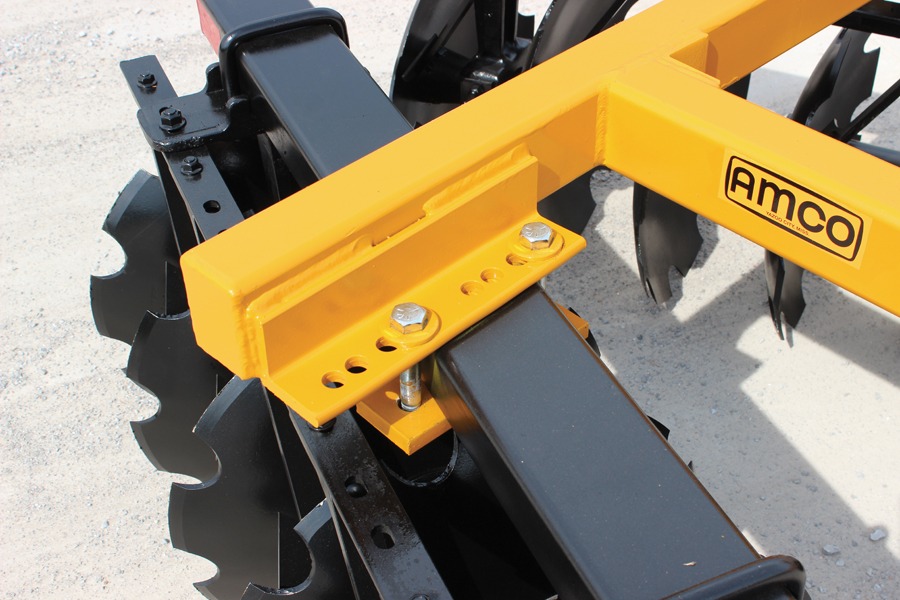Disc cutting depth has a major impact on overall crop yield. Cutting too shallow may lead to weak root systems, varying soil temperatures, and uneven emergence. Cutting too deeply puts unnecessary strain on equipment.
But setting and maintaining the ideal cutting depth is a delicate balance. To help you master it, AMCO has created this list of five key factors you need to consider while setting up and operating your disc.
Blade diameter
 When setting your disc’s tillage depth, the first thing to consider is blade diameter. Over the years, AMCO’s tough tillage experts have found that the ideal cutting depth in normal operating conditions is approximately 25% of the blade diameter. For example, for a 32″ blade, the cutting depth is about 8″. But for a 26″ blade, the cutting depth is about 6.5″.
When setting your disc’s tillage depth, the first thing to consider is blade diameter. Over the years, AMCO’s tough tillage experts have found that the ideal cutting depth in normal operating conditions is approximately 25% of the blade diameter. For example, for a 32″ blade, the cutting depth is about 8″. But for a 26″ blade, the cutting depth is about 6.5″.
Once you’ve calculated optimal tillage depth, set your disc to that depth using the depth controls.
Weight per blade
While it may be tempting to jump right into the field after setting the tillage depth, other factors must be taken into consideration. For example, the more weight a blade carries, the deeper it will cut—no matter the diameter.
Weight per blade is calculated by dividing the weight of the disc by the number of blades. Make a short test pass in an area similar to where you’ll be tilling and measure the depth of the blade furrow. If the furrow is deeper than one quarter of the blade diameter, there is too much weight on the blade. Relieve the pressure by reducing the tillage depth using the depth controls. If it’s too shallow, increase the pressure by increasing the tillage depth.
Blade angle
Like weight per blade, blade angle effects tillage depth. Specifically, setting the blades at a sharp angle increases blade penetration, while a shallow angle decreases penetration.
As you make adjustments to factor in weight per blade, also consider adjusting the blade angle. Keep making adjustments and performing test passes until the disc furrow measures one quarter of the blade diameter.

Blade angle can have a significant impact on tillage depth. Whether you are using AMCO’s LOF Lift Offset Harrow (pictured) or another unit, make sure to check the angle of your blades and make adjustments as needed using the gang angle.
Speed
Even if your disc is locked in to all the right settings, field and operating conditions can impact your disc’s cutting depth. For example, operating a disc too fast or too slow prevents it from penetrating the soil at the correct depth. The disc won’t be able to effectively break up and toss the soil, which leads to shallow cuts.
In most conditions, the optimal operating speed is approximately 4–6 miles per hour. In sandier soils, discs can be operated up to 8 miles per hour. If you are unsure what the right speed is for your soil conditions, make a few test passes at different speeds and measure the furrow depth.
Soil conditions
Like speed, soil conditions can have a major effect on tillage depth. In sandy soil, the disc may sink and cause the blades to cut too deeply. Tough, chunky “gumbo” soil might keep your disc from getting the correct penetration. If that’s the case, extra passes might be required.
As you make test passes during the set-up phase, you should get a good feel for the soil condition you’ll be working in, and you can make the proper adjustments. Just make sure to keep an eye out for changing soil conditions as you till–if you sense a change, check the depth of your furrows and make adjustments if necessary.
Getting your disc to cut at the correct depth often requires set-up time, but it’s well worth it when you achieve good yields and a return on your investment. To learn more about setting and operating your disc at the right tillage depth, contact our tough tillage experts today.
Did you know? A disc will incorporate residue into the ground roughly as deep as half the cutting depth. To break dirt clods most effectively, your second pass through the field should not be on the same angle as the first pass. Instead, enter the field anywhere from 30° to 90° off the angle of the first pass; this will help reduce streaks in the residue and provide a smoother soil finish.